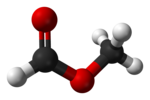| |||

| |||
| Names | |||
|---|---|---|---|
| Preferred IUPAC name
Methyl formate | |||
| Systematic IUPAC name
Methyl methanoate | |||
| Other names
R-611
| |||
| Identifiers | |||
3D model (JSmol)
|
|||
| ChEBI | |||
| ChEMBL | |||
| ChemSpider | |||
| ECHA InfoCard | 100.003.166 | ||
| EC Number |
| ||
PubChem CID
|
|||
| UNII | |||
CompTox Dashboard (EPA)
|
|||
| |||
| |||
| Properties | |||
| C2H4O2 | |||
| Molar mass | 60.052 g·mol−1 | ||
| Appearance | Colorless liquid | ||
| Odor | pleasant[1] | ||
| Density | 0.98 g/cm3 | ||
| Melting point | −100 °C (−148 °F; 173 K) | ||
| Boiling point | 32 °C (90 °F; 305 K) | ||
| 30% (20°C)[1] | |||
| Vapor pressure | 634 hPa (476 mmHg) (20°C)[1] | ||
| -32.0·10−6 cm3/mol | |||
| Hazards | |||
| GHS labelling:[3] | |||
 
| |||
| Danger | |||
| H224, H302, H319, H332, H335 | |||
| P210, P233, P240, P241, P242, P243, P261, P264, P270, P271, P280, P301+P312, P303+P361+P353, P304+P312, P304+P340, P305+P351+P338, P312, P330, P337+P313, P370+P378, P403+P233, P403+P235, P405, P501 | |||
| NFPA 704 (fire diamond) | |||
| Flash point | −19 °C; −2 °F; 254 K[1] | ||
| Explosive limits | 4.5%-23%[1] | ||
| Lethal dose or concentration (LD, LC): | |||
LD50 (median dose)
|
1622 mg/kg (oral, rabbit)[2] | ||
LCLo (lowest published)
|
50,000 ppm (guinea pig, 20 min)[2] | ||
| NIOSH (US health exposure limits): | |||
PEL (Permissible)
|
TWA 100 ppm (250 mg/m3)[1] | ||
REL (Recommended)
|
TWA 100 ppm (250 mg/m3) ST 150 ppm (375 mg/m3)[1] | ||
IDLH (Immediate danger)
|
4500 ppm[1] | ||
| Safety data sheet (SDS) | Oxford MSDS | ||
Except where otherwise noted, data are given for materials in their standard state (at 25 °C [77 °F], 100 kPa).
| |||
Methyl formate, also called methyl methanoate, is the methyl ester of formic acid. The simplest example of a carboxylate ester, it is a colorless liquid with an ethereal odour, high vapor pressure, and low surface tension. It is a precursor to many other compounds of commercial interest.[4]




